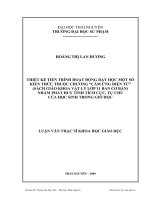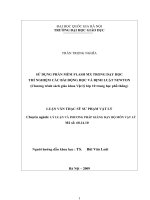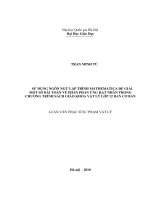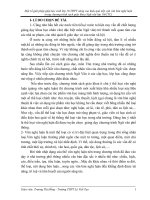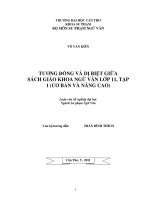English10 UNIT9 SGK Tiếng Anh 10 Cơ bản
Bạn đang xem bản rút gọn của tài liệu. Xem và tải ngay bản đầy đủ của tài liệu tại đây (188 KB, 14 trang )
English 10
UNIT 9. UNDERSEA WORLD
A. READING
Before you read
Work with a partner. Look at map and give the Vietnamese names for the oceans on the
map. (Làm việc với một bạn cùng học. Nhìn bản đồ và viết tên những đại dương trên bản đồ
bằng tiếng Việt.)
Pacific Ocean: Thái Bình dương;
Atlantic Ocean: Đại Tây dương;
Indian Ocean : Ấn Độ dương;
Antarctic Ocean: Nam Băng dương;
Arctic Ocean: Bắc Băng dương.
Work with a partner: Look at the pictures below. Can you name the sea animal in each
picture? The first letter of the word has been given to help you.
Seal: hải cẩu;
Jellyfish: con sứa;
Turtle: rùa biển;
Shark : cá mập.
While you read
Read the text and do the tasks that follow.
There is only one ocean. It is divided into five different parts: the Pacific, Atlantic, Indian,
Antarctic, and Arctic Oceans. There are also many other smaller seas, gulfs and bays which form
part of them. Altogether they cover 75 percent of the earth's surface. For centuries, people have
been challenged by the mysteries that lie beneath the ocean. However, today's scientists have
overcome many of the challenges of the depth by using modern devices. They send submarines
to investigate the seabed and bring samples of marine life back to the surface for further study.
Satellite photographs provide a wide range of information, including water temperature, depth
and the undersea populations. If modern technology did not exist, we would never have such
precious information.
Marine plants and animals fall into three major groups. Some of them live on or depend on
the bottom like the starfish. Some are swimming animals such as fishes and sharks that move
independently of water currents while others are tiny organisms that are carried along by the
currents like the jellyfish. Plants and animals of the sea, however small or oversized, all
contribute to its biodiversity. Unless this biodiversity were maintained, marine life would be at
stake.
Chỉ có một đại dương. Nó được chia làm năm phần : Thái Bình dương, Đại Tây dương, Ấn
Độ dương, Bắc Bắng dương, Nam Băng dương. Cũng có nhiều biển nhỏ hơn khác vịnh và vịnh
tạo thành một phần của đại dương. Tất cả bao phủ 75 phần trăm bề mặt trái đất. Trải qua bao
thế kỷ, con người bị thách thức bởi những điều kỳ bí nằm bên dưới đại dương. Tuy nhiên các
nhà khoa học hiện nay đã vượt qua nhiều thách thức của chiều sâu bằng cách dùng những
phương tiện hiện đại. Họ gởi những tàu ngầm để khảo sát đáy đại dương và mang những mẫu
vật của đời sống bể trở về mặt đất để nghiên cứu xa hơn. Các hình vệ tinh cung cấp đủ loại
thông tin. Bao gồm nhiệt độ nước, chiều sâu và các cư dân dưới biển. Nếu kỹ thuật hiện đại
không hiện hữu, chúng ta không bao giờ có những thông tin quý giá như thế.
Động thực vật biển được chia làm ba nhóm chính. Một số trong chúng sống hoặc lệ thuộc
đáy đại dương như hải tinh (sao biển). Một số là những động vật biết bơi như cá và cá mập di
chuyển độc lập với các dòng nước trong khi các động vật khác là những sinh vật tí ti được dòng
nước mang đi như con sứa. Các động thực vật biển, dù nhỏ hay quá khổ, tất cả góp phần vào sự
đa dạng sinh học của nó. Trừ khi sự đa dạng sinh học này được bảo tồn, nếu không thì sự sống
ở biển bị lâm nguy.
Task 1: The words in thr box all appear in the passage. Fill in each blank with one of them.
There are more words than needed.
1.
Some plants and animals are referred to as _______________ organisms because they are
extremely small.
2.
Thanks to modern technology, scientists have been able to _______________ the life of
plants and animals that live under the sea.
3.
A _______________ is a large area of sea that is partly surrounded by land.
4.
_______________is a term that refers to the existence of different kinds of animals and
plants which make a balanced environment.
5.
These scientists have collected different________________ to analyse for their
experiment.
1. tiny
2. investigate
3. gulf
4. bioadversity
5. samples
Task 2: Read the passage again and then answer the following questions.
1.
What percentage of the earth's surface is covered by seas and oceans?
=> 75% of the earth’surface is covered by sea and oceans.
2.
How do scientists now overcome the challenges of the depth?
=> They now overcome the challenges of the depth by using modern devices.
3.
What can submarines do to help scientists know about the undersea world?
=> They investigate the seabed and bring samples of the marine life back to the surface for
further study.
4.
What can we learn from the satellite photos?
=> We can know a wide range of information, including water temperature, depth and the
undersea population.
5.
What are the three groups of marine plants and animal?
=> They are those that live on or depend on the bottom like the starfish, those that move
independently of water currents and those that are carried along by the currents like the
jellyfish.
6.
What would happen if the sea biodiversity were not maintained?
=> The marine life would be at stake if the sea bioadversity were not maintained.
After you read
Work in pairs. Complete the summary of the reading passage by filling each blank with a word
or phrase given in the hox below.
plants and animals, discoveries, huge, closely connected, modem three-quarters,
mysterious, biodiversity.
Though covering (1)_______________ of the earth's surface, the ocean has remained (2)
_______________ to us until recently With (3) _______________ technology we have now
made important (4) _______________ about the (5) _______________ of marine life. We have
learnt that whether tiny or (6) _______________, all the (7) _______________ of the sea are
(8) ______________.
1. three-quarters
2. mysterious
3. modern
5. bioadversity
6. huge
7. plants and animals
4. discoveries
8. closely connected
B. SPEAKING
Task 1. Below are some actions that would be taken to protect our oceans. Work in pairs. Put the
actions in the order of importance and then say what we should or should not do.
a) Place rubbish and plastic bags in proper dustbins.
b) Use water sparingly and do not pollute it.
c) Do not fish for species that are limited, threatened or endangered.
d) Dispose of fishing lines and nets properly, not in or near the water.
e) Do not use herbicides, pesticides and fertilizers that harm the environment.
f) Learn all you can about the oceans.
g) Keep only the fish that you will eat; release the rest.
h) Be a smart shopper and choose your seafood responsibly.
1. f: I think action f is the most important because if we learn all about the oceans we can
understand their values and try to protect them.
2. e: We do not use herbicides, pesticides and fertilizers that harm the environment.
3. c: We do not fish for species that are limited, threatened or endangered.
4. d: We should dispose of fishing lines and nets properly.
5. g: We keep only the fish we will eat and release the rest. We should do all actions e, c, d and
g to maintain and protect marine life.
6. a and b: We should place rubbish and plastic bags in proper dustbins and
use water sparingly and do not pollute it.
7. h: We should choose our seafood responsibly.
Task 2. Work in groups. Below are some threats to the health of the oceans. Discuss the
consequences that might occur and offer some possible solutions.
1. Beaches are filled with plastic bags, pieces of glass and cigarette butts.
2. Whales and sharks are still hunted for food, medicine, and other products.
3. Explosives are used to catch fish and other sea animals.
4. Oil is spilled from tankers.
Example:
A: Beaches are filed with plastic bags, pieces of glass and cigarette butts. This makes the sea
polluted and endangers sea plants and animals.
B: We should clean beaches and tell other people not to litter them.
A. Beaches are filled with plastic bags, pieces of glass and cigarette butts. This makes the
sea polluted and endanger sea plants and animals. And we should clean up beaches and
tell people not to litter them.
B. We also should set up posters at holiday resorts, especially on the beaches, and have the
campaign of "Keep our environment clean and beautiful” in schools, that is we should
educate children and people about a clean and healthy environment.
C. Whales and sharks are still hunted for food, medicine and other products. This makes
these sea animals extinct some day.
D. So all governments should have laws that prohibit the hum for these endangered sea
animals lor any purpose. And I think restaurants in the world don’t serve the food made
from these animals' meat.
Task 3. Report to the class what your group has discussed.
My group has discussed the threats to beaches which are now being polluted with all
kind of rubbish such as plastic bags, pieces of glass and cigarette butts, etc. And we think that in
order to rescue beaches, we should clean them up and at the same time tell everybody not to
litter them. Besides these, we should educate people how important a healthy environment can
be to our life! And this project should be carried out in schools so that small school population
can get a good habit of conserving environment from early ages.
C. LISTENING
Before you listen
Work in pairs. Discuss the following questions
1. Do you think whales are fish? Why (not)?
No. Whales are not fish, they are mammals because they raise their young ones on milk.
2. Why do people keep hunting whales?
Because whales can produce food, oil, leather and other products for man.
While you listen
Task 1. Listen to some information about whales and decide whether the following statements
are true (T) or false(F).
1. The whale is the third largest animal that has ever lived on Earth.
2. Whales are said to be the most intelligent animals in the ocean.
3. Some whales are known to move into warm waters to give birth.
4. Whales are in danger because of the increase in population of other sea animals.
5. Some people are still killing whales for food.
1.F
2.T
3.T
Task 2. Listen again and then answer the following questions.
4. F
5. T
1. What is the length and weight of the blue whale?
A blue whale can grow to 30 meters length and over 200 tons weight.
2. Why do whales like to feed in the cold oceans?
Because there are a lot of krill there, their favourite food.
3. According to the listening passage, what are the food feeding grounds for whales?
Cold waters in the North and South Atlantic Ocean and the North and South Pacific
Ocean are their good feeding grounds.
4. What is the main reason for the decrease in whale populations?
Heavy hunting is the main reason for the decrease in the whale populations.
5. What have conservation groups asked the International Whaling Commission to do?
They have asked the International Whaling Commission to stop most whaling.
6. What would happen if we didn't take any measures to protect whales?
If we didn’t take any measure to protect whales, they would disappear forever soon.
After you listen
Work in groups. Talk about whales, using the following cues.
their length and weight
their feeding grounds and food
the reasons for protecting whales
Whales are very big. They’re the largest sea animals. They’re about 30 metres long and weigh
about 200 tons. Their feeding grounds are in cold waters in the North and South Atlantic and the
North and South Pacific Oceans because in these water currents there are a lot of krills, their
favourite food. Now, Conservation Groups are trying to protect whale population from being
extinct.
D. WRITING
Describing information from a table
Task 1: Work in pairs. Read the descnplion of the sperm whale and then complete the table that
follows.
Sperm whales are the biggest animals on Earth that have teeth. They are carnivores, which
means they eat meat. Although sperm whales can be found in all oceans, they prefer the waters
with high squid populations, which are their main diet. A sperm whale can eat up to 1,500 kg of
food each day. Sperm whales are big animals. The males can grow up to 18 metres long and
weigh up to 54,000 kg while the females are a bit smaller with a length of 12 metres and a
weight of 17,000 kg. A female sperm whale gives birth to one calf every five to seven years after
a gestation period of fourteen to nineteen months. The life span of sperm whales can be up to
sixty or seventy years. It is interesting to know that they also have the largest brain of any
mammals. Sperm whale populations are at risk due to hunting and their accidental entrapment in
fishing nets.
Cá nhà táng là động vật lớn nhất trên trái đất có răng. Chúng là động vật ăn thịt, nghĩa là
chúng ăn thịt. Mặc dù cá nhà táng có thể tìm thấy ở tất cả đại dương, chúng thích những dòng
nước với cư dân mực đông đúc, là thức ăn chính của chúng. Một con cá nhà táng có thể ăn đên
1.500 kilo thức ăn mỗi ngày. Cá nhà táng là những động vật lớn. Con đực có thể phát triển đến
18 thước chiều dài và cân nặng đến 54.000 kg, trong khi con cái hơi nhỏ hơn một tí với chiều
dài 12 thước và nặng 17.000 kg. Một con cá nhà táng cái, lừ năm đến bảy năm đẻ một con một
lần sau thời kỳ thai nghén từ 14 đến 19 tháng. Cuộc đời của cá nhà láng có thể đến 60 hay 70
năm. Thật thú vị khi biết chúng cũng có bộ óc lớn nhất trong loài có vú. Cá nhà táng đang gặp
nguy hiểm vì việc săn bắn và sự tình cờ mắc vào lưới đánh cá của chúng ta.
SPERM WHALE
RANGE & HABITAT
all oceans - waters with high squid population
SIZE
Male :18 m long; 54,000 kg; female: 12 m long 17,000 kg
FEEDING HABITS
Canivores: squid; 1,500 kg a day
OFFSPRING
One calf every 5 or 7 years; gestation: 14-19 months
LIFE SPAN
60-70 years
SPECIAL FEATURES
Biggest animals with teeth, having the largest brain
CONSERVATION CONCERNS
At risk clue to hunting and accidental entrapment in nets
Task 2: The table on the next page gives some information about the dolphin. Write a paragraph
that describes the facts and figures provided in the table.
DOLPHIN
RANGE & HABITAT
Oceans worldwide; Prefer coastal waters and bays.
SIZE
Smallest: about 50 kg and 1.2m
Largest: up to 8,200 kg and 10m
FEEDING HABITS
Carnivores: Eat mostly fish
OFFSPRING
Give birth to one calfe very 2 years
Gestafion period:11-12 months
LIFE SPAN
From 25 to 65 years
Sometimes longer, depending on the species
SPECIAL FEATURES
Mammals, not fish
Among the most intelligent animals
CONSERVATION CONCERNS
At risk due to habitat pollution and accidental
Fishing net entrapment
Dolphins are mammals, not fish, but they live in water. Dolphins are among the most
intelligent animals on Earth. Although they can be found in all oceans worldwide, but they
prefer coastal waters and bays. Dolphins’ size vary according to their species. The smallest
dolphin is about 50 Kilograms in weight and 1.2 metres in length, meanwhile the largest dolphin
can weigh up to 8.200 kilograms and be 10 metres long. Dolphins are canivores and cat mainly
fish. A female dolphin eives birth to one calf every two years after a gestation period of eleven
to twelve years. The life span of Dolpinhs can be from twenty-five to sixty-five years, and some
species can even live longer. Dolphin population is at stake due to the pollution of their habitats
and accidental entrapment in fishing nets.
E. LANGUAGE FOCUS:
Pronunciation: /ɪə/ - /eə/ - /ʊə/
Grammar:
1. Should
2. Conditional sentence type 2
Pronunciation
o Listen and repeat.
/ɪə/
/eə/
/ʊə/
here
pair
poor
dear
chair
sure
clear
square
tour
idea
where
usual
cheers
upstairs
casual
atmosphere
carefully
actually
o Practise these sentences.
1. Let’s have some beer, dear.
2. What a good idea! The atmosphere here is very clear.
3. Where are my shoes? They are nowhere here.
4. Have you looked carefully everywhere?
5. I am sure he is far from poor.
6. Well, actually he usaully wears casual clothes.
Grammar and vocabulary:
Grammar:
1. Should
Used to show what is right, appropriate, etc., especially when criticizing somebody’s actions
You shouldn't drink and drive.
He should have been more careful.
A present for me? You shouldn't have! (= used to thank somebody politely)
Used for giving or asking for advice
You should stop worrying about it.
Should I call him and apologize?
I should wait a little longer, if I were you.
(ironic) ‘She doesn't think she'll get a job.’ ‘She should worry, with all her
qualifications (= she does not need to worry).’
Used to say that you expect something is true or will happen
We should arrive before dark.
I should have finished the book by Friday.
The roads should be less crowded today.
Used to say that something that was expected has not happened
It should be snowing now, according to the weather forecast.
The bus should have arrived ten minutes ago.
(British English, formal) used after I or we instead of would for describing what you would
do if something else happened first
If I were asked to work on Sundays, I should resign.
(formal) used to refer to a possible event or situation
If you should change your mind, do let me know.
In case you should need any help, here's my number.
Should anyone call (= if anyone calls), please tell them I'm busy.
Used as the past form of shall when reporting what somebody has said
He asked me what time he should come. (= His words were: ‘What time shall I
come?’)
(British English, formal) I said (that) I should be glad to help.
(British English) used after that when something is suggested or arranged
She recommended that I should take some time off.
In order that training should be effective it must be planned systematically.
Note: In both North American English and British English this idea can be expressed without
‘should’:She recommended that I take some time off.In order that training be effective…
Used after that after many adjectives that describe feelings
I'm anxious that we should allow plenty of time.
I find it astonishing that he should be so rude to you.
(British English, formal) used with I and we in polite requests
I should like to call my lawyer.
We should be grateful for your help.
Used with I and we to give opinions that you are not certain about
I should imagine it will take about three hours.
‘Is this enough food for everyone?’ ‘I should think so.’
‘Will it matter?’ ‘I shouldn't think so.’
Used for expressing strong agreement
‘I know it's expensive but it will last for years.’ ‘I should hope so too!’
‘Nobody will oppose it.’ ‘I should think not!’
Why, how, who, what should somebody/something do used to refuse something or to show
that you are annoyed at a request; used to express surprise about an event or a situation
Why should I help him? He's never done anything for me.
How should I know where you've left your bag?
I got on the bus and who should be sitting in front of me but Tony!
used to tell somebody that something would amuse or surprise them if they saw or
experienced it
You should have seen her face when she found out!
2. Conditional sentence type 2
Second conditional
The second conditional is used to talk about ‘unreal’ or impossible things.
If I won a lot of money, I’d buy a big house in the country.
Where would you live if you could live anywhere in the world?
If you didn’t smoke so much, you’d feel a lot better.
The structure is usually if + past simple and would + infinitive. It’s not important which clause
comes first.
Look at the difference between the first and second conditionals.
In January: If it snows tomorrow, I’ll go skiing. It might snow tomorrow.
In August: If it snowed tomorrow, I’d go skiing. It almost certainly won’t snow tomorrow.
NOTE: Although many conditional sentences use if + will/would, conditional sentences can also
use other words instead of ‘if’ – e.g. ‘when’ ‘as soon as’ ‘in case’ Other modal verbs can be used
instead of ‘will/would’ – e.g. ‘can/could’, ‘may’ ‘might’.
Exercise 1. For each situation in brackets write a sentence with should or shouldn't + one of
the phrases in the box below.
Go away for a fewdays; go to bed so late; look for another job; put some pictures on the
walls; take a photograph; use her car so much
1. (Lizneedsachange.) She should go away for a few days.
2. (My salary is very low.) You __________________________________________.
3. (Jack
always
has
difficulty
_____________________________________.
getting
up.)
He
4. (What a beautiful view!)You __________________________________________.
5. (Sue drive severy where. She never walks.) She _______________________________.
6. (Bill's room isn't very interesting.) He ______________________________________.
Answers:
1. She should go away for a few days.
2. You should look for another job.
3. He shouldn't go to bed so late.
4. You should take a photograph.
5. She shouldn't use her car so much.
6. He should put some pictures on the wall.
Exercise 2. Read the situations and write sentences with I think / I don't think... should....
1. Peter and Judy are planning to get married. You think it's a bad idea. (getmarried)
I don't think they should get married.
2. You don't like smoking, especially inrestaurants. (bebanned)
I think___________________________________________________________________.
3. I have a very bad cold but I plan to go out this evening.You don't think this is a good idea.
You say to me: (go out)___________________________________________________.
4. You are fed up with the boss. You think he has made too many mistakes.
(resign)_____________________________________________________________________.
Answers:
1. I don't think they should get married.
2. I think smoking should be banned, especially in restaurants.
3. I don't think you should go out this evening.
4. I think the boss should resign.
Exercise 3. Put the verbs into the correct form.
1. They would be rather offended if I didn’t go to see them. (not/go)
2. If you exercised more, you would feel better. (feel)
3. If I were offered the job, I think I __________ it. (take)
4. I’m sure Anny will lend you the money, I’d very surprised if she ____________. (refuse)
5. If I sold my car, I __________________ much money for it. (not/get)
6. A lot of people would be out of work if the factory ________________. (close down)
7. What would happen if I __________________________ that red button? (press)
8. Liz gave me this ring. She _______________________ very upset if I lost it. (be)
9. Mark and Carol are expecting us. They would be very disappointed if we ______. (not/come)
10. Would Tim mind if I _________________ his bicycle without asking him? (borrow).
11. If somebody ______________________ here with a gun, I’d be very frightened. (walk)
12. I’m sure Sue ___________________ if you explained the situation to her. (understand)
1. didn't go
2. would feel
3. would take
4. refused
5. would not get
6. closed down
7. pressed
8. would be
9. didn't come
10. borrowed
11. walked
12. would understand
Vocabulary:
Word
Transcript
Cl
as
s
Meaning
Example
At stake
/ət steɪk/
n
Bị đe dọa
Thousands of lives will be at stake if emergency aid
does not arrive in the city soon.
Biodiversity
/ˌbaɪəʊ da ɪˈvɜːsɪti n
Đa dạng sinh
học
A new National Biological Survey will protect species
habitat and biodiversity.
Carnivore
/ˈkɑːnɪvɔːr /
Động vật ăn thịt
Lions and tigers are carnivores.
n
Dolphin
/ˈdɒlfɪn/
n
Cá heo
Among sea animals, I like dolphins the most.
Entrapment
/ɪnˈtræpmənt/
n
Sự đánh bẫy,
mắc bẫy
Sperm whale populations are at risk due to hunting
and their accidental entrapment in fishing nets.
Gestation
/dʒesˈteɪʃən/
n
Gulf
/gʌlf/
n
Vịnh, vùng vịnh
The gulf of Tonkin is in the South China Sea.
Herbicide
/ˈhɜːbɪsaɪd/
n
Thuốc diệt cỏ
Herbicides are widely used in agriculture to kill
unwanted plants.
Jellyfish
/ˈdʒelifɪʃ/
n
Con sứa
The jellyfish is a sea animal with a soft oval almost
transparent body.
Sự thai nghén
The gestation period of rats is 21 days
Krill
/krɪl/
n
Con tôm (rất
nhỏ, sống ở
Krill are very small animals with a hard outer shell
vùng biển quanh which live in the sea and are eaten in large numbers
Nam Cực),
by some types of whale.
nhuyễn thể
Offspring
/ˈɒfsprɪŋ/
n
Con cái, con đẻ
In the case of the guinea pig, the number of offspring
varies between two and five.
Organism
/ˈɔːgənɪzəm/
n
sinh vật cá thể
Amoebae and bacteria are single-celled organisms.
Reveal
/rɪˈviːl/
v
Tiết lộ
He was jailed for revealing secrets to the Russians.
Seal
/siːl/
n
Con hải cẩu
Now, we can see many seals at some aquariums.
Shark
/ʃɑːk/
n
Cá mập
The movie 'Jaws' is about a man-eating shark.
Sperm whale /spɜːm weɪl/
n
Cá nhà táng
The sperm whale is a large whale with a very large
long head.
Starfish
/ˈstɑːrfɪʃ/
n
Con sao biển
The starfish is a beautiful fish.
Submarine
/ˌsʌbməˈriːn/
n
Tàu ngầm
They have sent a submarine to investigate the
seabed.
Turtle
/ˈtɜːtl/
n
Rùa biển
The turtle is an animal which lives in or near water
and has a thick shell covering its body.
Whale
/weɪl/
n
Cá voi
The whale is a very large sea mammal that breathes
air through a hole on the top of its head.

